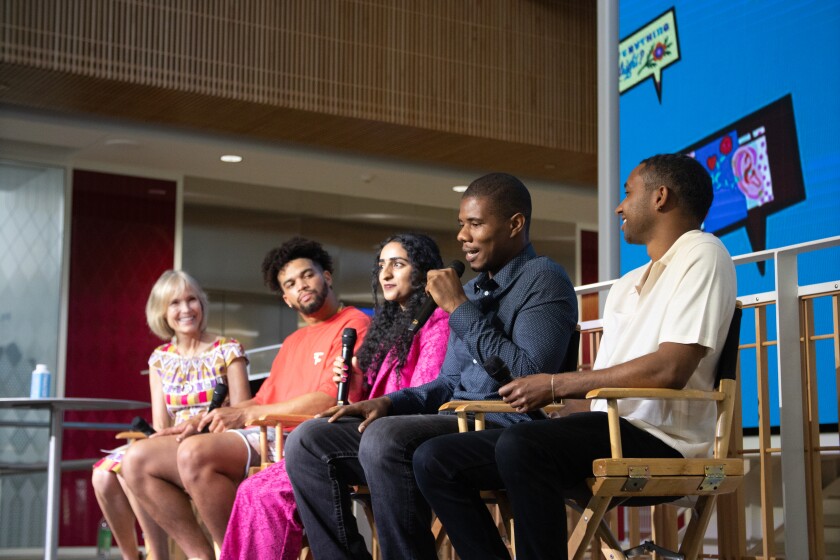As communicators, forming an authentic connection with your intended audience is a total touchdown. So, if we want so badly for audiences to feel seen and heard, why not give them a direct line into the storytelling process?
This September, during Suicide Prevention Month, the Seize the Awkward campaign teamed up with the Caleb Cares Foundation and the Annenberg School for Communication and Journalism at the University of Southern California to do exactly that – create a new public service advertisement (PSA) for young adults, by young adults. The video, featuring star quarterback and mental health advocate Caleb Williams, was ideated, filmed, directed and edited by Annenberg students.
Seize the Awkward, created by the American Foundation for Suicide Prevention (AFSP) and The Jed Foundation (JED) in collaboration with the Ad Council, is a campaign that encourages young adults 16 to 24 years old to reach out to their friends and start the conversation around mental health. Since aspiring communications students fall into that group, they were a natural fit to lend their firsthand expertise, while also gaining valuable experience along the way.
Throughout the summer, a team of students led by co-directors Christian John Bradley and Shreya Ranganathan worked diligently to highlight Caleb’s personal experiences with mental health, leverage campaign insights and layer in their own perspective on the importance of checking in with friends. The final product was a PSA that was not only impactful, but authentic. Watch the PSA here.
“Diverse audience voices are so important for good, authentic storytelling, which I learned experientially through my participation in this PSA. I felt like I had a voice that mattered,” said Ranganathan, a senior undergraduate journalism student with a minor in screenwriting. “Oftentimes, organizations and those in positions of leadership tend to report and profile certain experiences without actually being involved in them firsthand. Personally, as a student and woman of color involved in the storytelling process surrounding mental health, I was able to bring my own life experiences to the table and help more individuals like me see themselves represented in the media they consume.”
“The most impactful stories are those we connect with because, on some level, we find ourselves in them. This is why it is so important to incorporate audience voices into the storytelling process, because the most effective way to resonate with your audience is to speak their language authentically,” added Bradley, a graduate student receiving his M.A. in sports journalism this spring. “During the PSA, Shreya and I told from our unique perspectives to connect with young adults. I said many times, ‘That is not a lens you are speaking to, it is that friend in need you were there for.’”

Since the PSA premiered at an on-campus panel event in September, the benefit of audience-produced content is already proving to be significant. Student journalists have covered the work, starting natural conversations about mental health with their fellow young adult readers. Fans and classmates are commenting with messages of support on social media. With more than 9.5K views of the PSA, it’s clear that the content is resonating, thanks to firsthand relatable experiences in the production room reflected on screen.
“The most effective way to incorporate young adult voices into the storytelling process is by spending quality, not results-focused, time with young adults to listen. One meaningful encounter can develop a true connection and shed light on revelations that could not be discovered any other way. These nuggets of perspective add richness to the story,” said Bradley. “This approach also builds a true relationship that goes beyond any deliverable and focuses on telling the most impactful story to the people who need to be impacted the most.”
In addition to the content itself, a collaborative project like this one also provides the opportunity for all partners involved to help develop future industry talent and reaffirm their commitment to representing real voices in storytelling. For the students involved, and for any audience member with the opportunity to contribute to a national campaign, this type of work helps to strengthen their portfolios and gives them a glimpse into campaign work outside of the classroom.
“Brands and marketers can allow young adults to participate in all tiers of the storytelling process, from pitch to production to post-production. Young adult creatives are eager to contribute, but need an open door and platform in order to do so– and to display the art they want to bring into the world,” Ranganathan explained. “Brands and marketers should design roles for young adults to help accelerate their storytelling voice and showcase possibilities like never before.”
Connecting with educational institutions for young adult projects is just one way you can include your intended audience in the creative process. Consider working with agencies owned and operated by your key audience, like veteran-owned agency We Are the Mighty’s work on the Ad Council’s End Family Fire, Veterans Crisis Prevention and Caregiver Assistance campaigns. Highlight real stories in front of the camera, as seen in our Tear the Paper Ceiling and When You Graduate, They Graduate campaigns. Opportunities exist at every stage in the campaign cycle.
As you develop your next campaign or creative work, consider how you might include firsthand audience perspective into the process beyond the traditional research phase. What opportunities are there to tap into the creativity, authenticity and emotion that only firsthand experience can provide?
When you build in direct connection throughout the production process with the folks you’re trying to reach, you’re bound to have a product that feels more personal and powerful. The question is not if, but how you’re bringing in those voices behind the scenes.


